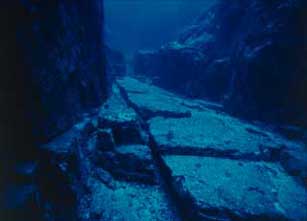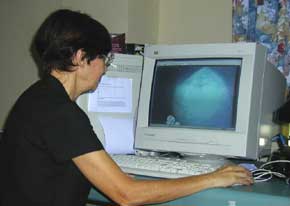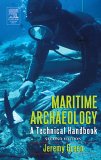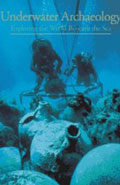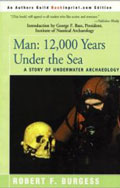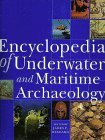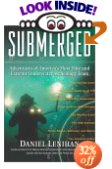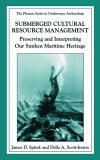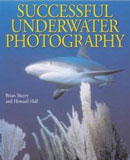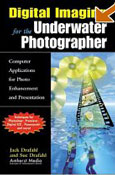|
“Shallow Lake Okeechobee reveals pool of relics”
June 28, 2007, Miami Herald, USA:
“The epic drought gripping Lake Okeechobee has opened a mud-spattered window into Florida’s past.
Since March, falling water levels have exposed 21 archaeological sites – for now, the locations a secret to the public. Thousands of artifacts have been unearthed, including pieces of pottery, shell pendants, candleholders, arrowheads and fishing weights – Human bones, too.
|
Boots Boyer was looking for pond apple seeds around Lake Okeechobee recently when he found a trove of bones and artifacts.
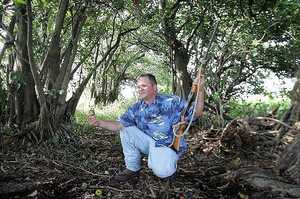
Miami Herald, USA
|
|
Archaeological teams from the state and Palm Beach County are hunting for still more relics before the rains take hold and they are lost to the lake again.
‘It isn’t exactly Indiana Jones’, said Briana Delano, a state archaeologist.
And yet, the endeavor evokes just that image. The sites are seven miles from the shore. By midday, team members say, the sun is blazing. The mosquitoes are relentless
|
Archaeologist and crew wear high boots to protect their legs from cottonmouths and sawgrass, all the while hoping to avoid confrontations with gators.”
[Full Story]
“Scientists seek to reveal Arctic secrets”
June 22, 2007, Cape Cod Times, USA:
“Exotic sea creatures never before seen by man. New varieties of plants and animals. Maybe even the clues to the origin of life on this planet.
All that could be discovered when an international team of scientists takes a first-ever peek under the ice packs of the Arctic Ocean next month, providing the world with a glimpse of an ocean region that has been in isolation from nearly all other ecosystems for at least 26 million years.
|
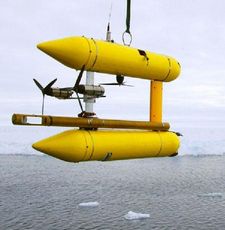
Cape Cod Times, USA
|
|
Led by Robert Reves-Sohn, a geophysicist from the Woods Hole Oceanographic Institution, scientists and engineers from the United States, Germany, Japan and Sweden will depart from Svalbard, Norway, on July 1 to study deep-sea hydrothermal vent sites along the Gakkel Ridge. This ridge, which extends 1,100 miles north of Greenland toward Siberia, ranges from 1.8 to 3 miles beneath the surface of the ocean, making it the deepest ocean ridge known to man.
|
Reves-Sohn and his team will search for deep sea hydrothermal vents along the ridge, formed when the North American and Eurasian tectonic plates spread apart, causing chemical reactions between the rocks of the Earth’s crust and the seawater that seeps down into them.”
[Full Story]
“Robot sub explores giant canyon”
June 19, 2007, BBC Science News, UK:
“Scientists have begun the first detailed exploration of a vast underwater valley the size of the Grand Canyon – just off the coast of Portugal – and it’s yielded a series of surprises.
Using Britain’s ISIS robot submarine – a van-sized bundle of high-technology – researchers are for the first time able to view previously hidden features up to 5km (three miles) deep in the Nazare Canyon.
|
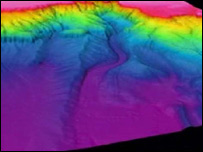
BBC Science News, UK
|
|
The canyon extends out into the eastern Atlantic from the seaside town of Nazare, north of Lisbon – long plotted on maps but until now never properly studied. The submarine is operated from the UK’s new research vessel, the James Cook, and during a visit on board I watched as it was winched over the side and lowered into the waves.
|
At a depth of 3,600m (12,000ft) the shape of a shark appeared to the amazement of scientists – usually sharks are never found deeper than 3,000m (1,000ft).
On the sides of the canyon, beneath the overhanging edges of the giant cliffs, cold-water corals are seen clinging to the rock, part of a highly active ecosystem well below the limits of sunlight.”
[Full Story]
“China treasure trove uncovered”
June 13, 2007, ITV News, UK:
“Archaeologists stumbled across a treasure trove of Ming Dynasty porcelain when they found an ancient sunken ship at the bottom of the South China Sea.
|
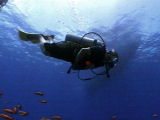
ITV News, UK
|
|
Divers used satellite navigation equipment to find the ship, dubbed South China Sea II, which is about 17 to 18 metres long and lying at a depth of 20 metres.
|
Archaeologist Dr Wei Jun said: ‘A preliminary study of the sunken ship shows it may have sunk 400 years ago after striking a reef.’
The vessel was discovered when local police learnt that some fishermen had been recovering ancient porcelain objects from the sea off the coast of Guangdong province.”
[Full Story]
“Bracelet? Knocker? Experts divided on gold rings’ function”
June 08, 2007, XinhuaNet, China:
“Bracelet or door-knocker? Archeologists are proffering their guesses as to the function of a pair of rings excavated from the ‘Nanhai No.1’ undersea archeological site, according to Guangzhou Daily reports.
|
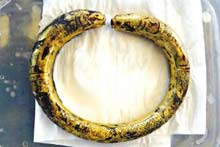
XinhuaNet, China
|
|
Tong Mingkang, vice director of the State Administration of Cultural Heritage, made the guess after he visited the archeological site in person, saying the so-called bracelet made of pure gold may actually be a semi-finished pair of dazzling knockers.
|
Tong said that this pair of rings is too big to be bracelets: bracelets often measure six or seven centimeters in diameter, while this pair of gold rings measures about 10 centimeters. Furthermore, they are not complete circles, with the upper part left open. Tong said he thinks this part to have been attached to a door, or a trunk.
Nanhai No.1 was found accidentally in 1987. The ship, more than 25 meters long, is the largest cargo ship from the Song Dynasty so far discovered.”
[Full Story]
“Korean octopus is a sucker for antiques”
June 06, 2007, NineMSN, Australia:
“A South Korean fisherman has reportedly discovered a precious haul of ancient pottery — thanks to an octopus which attached its suckers to a plate.
Kim Yong-Chul caught more than he bargained for when he went fishing on May 18, according to the website of the Chosun Ilbo newspaper seen Wednesday.
Shards of ancient celadon pottery were attached to the suckers of several webfoot octopuses which he netted. One was stuck to a complete plate dating back to the Koryo Dynasty, which ruled the peninsula from 916 to 1392.”
[Full Story]
“Ministry officials pour water on temple project”
June 05, 2007, The Nation, Thailand:
“Senior officials from the Culture Ministry yesterday expressed their objection to Phayao province’s Bt1-billion project to restore an ancient temple under the waters of Kwan Phayao – the largest freshwater fish habitat under its supervision in the upper North.
Fine Arts Department director-general Arak Singhitkul said he disagreed with the idea because the temple had been submerged for a long time and draining the water would result in severe erosion to the brick work, requiring even more restoration work.
Culture Minister Khunying Khaisri Sriaroon also disagreed with the attempt to restore the temple as another tourist attraction. She said that as there was no way the restoration could be done easily, it was not worth it. It would also affect locals who relied on fishing to survive.
Phayao Governor Thanasek Asawanuwat initiated the development project to restore Wat Tilak Aram, a temple thought to be more than 500 years old, that has been submerged since the lake was created 68 years ago.
The man-made lake was declared one of Thailand’s 61 most important wetland areas with global ecological significance by a Cabinet resolution on August 1, 2000.”
[Full Story]
“Research Continues At Supposed Blackbeard Shipwreck”
June 04, 2007, WSOCTV News, USA:
“Ten years and $2 million have yet to result in a ‘smoking blunderbuss’ that proves a shipwreck off the coast of Beaufort belonged to the notorious pirate Blackbeard. But researchers say they haven’t found anything among the cannons, coins, anchors, and other artifacts that rules it out.
‘Ten years of archaeological and historical research all say it’s the Queen Anne’s Revenge’, said Lindley Butler, of Wentworth, the historian on the shipwreck project.
Some state officials stop short of confirming the oldest shipwreck ever found in North Carolina waters belonged to Blackbeard. They say it’s best to remain cautious because the state’s reputation is on the line. ‘I … won’t let them’, said Jeffrey Crow, a deputy secretary of the N.C. Department of Cultural Resources. ‘There’s a slim possibility that it could be another shipwreck.’.
But even if it turns out not to be the French slave ship many believe Blackbeard captured in 1717 and renamed Queen Anne’s Revenge before it ran aground off Atlantic Beach a year later, the decade of research and examination have been worth the effort, said Jerry Cashion, chairman of the N.C. Historical Commission.
‘This is the most important maritime wreck in North Carolina regardless of what it is’, Cashion said. ‘ … It’s a treasure trove.’.
The French frigate measured about 100 feet long with three masts and a crew of 150 to 200. The shipwreck, discovered in late 1996, is within sight of Fort Macon State Park in 23 feet of water. ‘What you see is the ballast stone pile, large anchors and stacks of cannons’, Butler said of the 3-foot-high pile of artifacts that covers an area about 20 feet by 25 feet. ‘I have never seen anything like that.’.
Scientists believe the wreck of the Queen Anne’s Revenge has laid buried under the shifting sands of Beaufort Inlet.”
[Full Story]
“Archeological find to determine exact age of ancient Dwarka”
June 03, 2007, Daily News & Analysis, India:
“The exact age of Dwarka, the ancient submerged city off Gujarat coast, can now finally be determined.
In a major breakthrough, archaeologists have excavated from the ruins of Dwarka a wooden block that promises to solve the mystery about the exact age of the submerged city believed by many to belong to Lord Krishna.
|
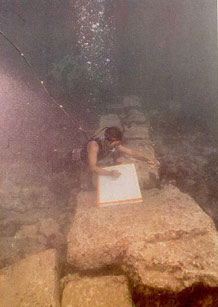
Daily News & Analysis, India
|
|
‘Now that we have found wood, we are confident of dating the excavations. We will know exactly how old is this submerged city’, Alok Tripathi, Superindenting Archaeologist of the Underwater Archaeology Wing of the Archaeological Survey of India.
Archaeologists will now use the carbon dating technique to determine the exact age of the ruins. The latest excavation at the site that began early this year concluded last week.
The earlier excavations, that first began about 40 years ago, had only revealed stones, beads, glass and terracotta pieces.
|
‘The operations resulted in retrieval of wooden block from a submerged circular structure. The blocks were joined so well with the help of wooden dowels and nails that they remained in situ despite heavy surfs and strong currents for a long period’ said Tripathi, who is also an expert diver.
The samples of the excavation have been brought to the capital and shall soon be given for lab testing.”
[Full Story]
“Scientists discover wooden lightning bolts
like ancient Aztec offerings”
May 25, 2007, IHT/AP, France:
“Archaeologists diving in a lake in the crater of a snowcapped volcano say they’ve found wooden lightning bolts matching what Spanish priests wrote about more than 500 years ago when they described offerings by Aztecs to their rain god Tlaloc.
Scuba-diving at more than 4,200 meters (13,800 feet) above sea level in one of the twin lakes of the extinct Nevado de Toluca volcano this month, the scientists said they found the lightning bolts, along with cones of copal incense and obsidian knives.
Mexico’s National Institute of Anthropology and History must still conduct tests to determine the age of the offerings, but say the wooden bolts could have survived for centuries in the frigid lake west of Mexico City, and fit the descriptions of Aztec rituals at the volcanic lakes that priests wrote about in the early 1500s during the Spanish conquest.
Lightning bolt scepters ‘were used by Aztec priests when they were doing rites associated with the god Tlaloc’, said Johan Reinhard, an anthropologist and explorer-in-residence for National Geographic Society who joined another research dive into the lake on Thursday.”
[Full Story]
“Perilous mission for underwater archaeologist”
May 24, 2007, The Daily Star, Egypt:
“It was dangerously stormy weather and high waves lashed down on the small Pharos Island where the Qaitby Citadel is located. Despite the unfavorable weather conditions, some underwater archaeologists had to brave it to try out some equipment the antiquities department is due to purchase.
One of them had just adjusted his heavy diving belt and was preparing to put on the rest of his diving gear when he was suddenly hit by a fierce wave, which in less than a minute caused him to drift out to the middle of the sea.
|
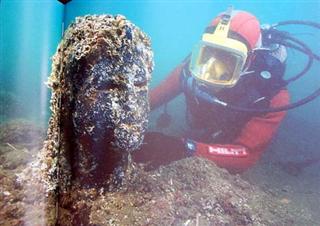
The Daily Star, Egypt
|
|
‘I really thought this was the end’, recalled Alaa Mahrus, a senior underwater archaeologist and currently head of the Underwater Antiquities Department, Alexandria.
Mahrus continued: ‘It was virtually impossible to swim to shore and all indications showed that I was going to drown. I would have had it not been for the initiative of my colleagues’.
|
‘I immediately took off the heavy belt that was pulling me down. The other parts of my diving equipment had been scattered around me. The other divers jumped into the water, got hold of my oxygen tank and flippers and pushed them in the direction of the spot where I was struggling with the waves. This was how by the grace of God I was rescued.’.
But this was only a small part of the many risks these adventurers are taking daily to uncover the secrets of scores and scores of antiquities that remain buried under the sea bed.
According to Mahrus, neither winter nor summer is the ideal time for underwater excavations. Exceptionally, some have to dive during these seasons for different purposes like testing new equipment or getting a view of a potential target.
The senior archaeologist explained: ‘Currently the sinking antiquities teams are working at various sites of our coast. May and June, then September, October and November are the golden times for people working in this field. The climatic conditions, that are the biggest obstacles for archaeologists, are mostly propitious’.”
[Full Story]
“Experts seek first Americans”
May 21, 2007, Norwich Bulletin, USA:
“The hunt for ancient peoples and cultures is going underwater.
Sunday, in honor of Historic Preservation Month, the fourth annual Tea and History Celebration at the Norwich Inn & Spa hosted two experts who have teamed up to study the ocean floor south of Block Island in search of clues to “ancient real estate” native people of North and South America may have once inhabited.
Robert Ballard, president of the Institute for Exploration at Mystic Aquarium, and Kevin McBride, director of research at the Mashantucket Pequot Museum and Research Center, want to explore 300 feet below sea level and 50 to 100 miles south of Block Island’s coast.
They hope to answer questions that have long been on the minds of scientists, including when native peoples arrived, where they came from, how they arrived and what they looked like.
The Clovis theory states native populations migrated in three waves across the Bering Strait from Asia, starting about 12,000 years ago during Ice Ages.
But that theory is quickly going out of mode because of recent discoveries of sites throughout North and South America that pre-date the previously discovered sites.
Scientists say because glaciers are more compact than water, more of the ocean floor was exposed. As glaciers moved south, creating rivers and lakes, they also melted and sea levels rose, covering areas humans may have inhabited.”
[Full Story]
“Atlantic wreck yields $500 million treasure”
May 19, 2007, San Francisco Chronicle, USA:
“A ship that sank as many as 300 years ago in busy waters of the Atlantic has delivered an unprecedented bounty to American treasure hunters: 17 tons of silver coins and hundreds of gold coins, jewelry and other objects.
The value, estimated by a rare coin dealer working with the firm, may be as much as $500 million.
The enormous find was revealed Friday by Odyssey Marine Explorations of Tampa, Fla., a publicly traded company that finds, explores and salvages shipwrecks in international waters. The company has made several major discoveries before, but they pale by comparison to the haul from what its officials code-named ‘Black Swan’.
The company said Friday in a release that it ‘believed that this recovery constitutes the largest collection of coins ever excavated from a historical shipwreck site’. The company was reluctant to give out details of its find.
‘Our research suggests that there were a number of Colonial-period shipwrecks that were lost in the area where this site is located, so we are being very cautious about speculating as to the possible identity of the shipwreck’, said John Morris, Odyssey’s co-founder and chief executive officer.”
[Full Story]
“Turkey’s underwater archeological treasures and challenges”
May 19, 2007, Turkish Daily News, Turkey:
“Turkey’s archeological riches are not limited to those under the earth. Surrounded by seas on three sides, Turkey attracts the curiosity of many local and foreign researchers with its underwater archeology.
In addition to many remains from antiquity, there are battleships and submarines from the World Wars I and II in the dark waters of Turkish seas. Underwater archeology researcher Selçuk Kolay complains about the lack of interest in our sunken treasures under the sea.
Kolay stated that the price of scrap iron rose with industrialization activities between the years 1960 and 1975. As a result of illegal diving to underwater historical remains, sunken ships were stripped and the pieces of iron were melted and resold.
Beginning to become interested in technical antiques when he was at the Berlin Technical University, Kolay said, ‘Approximately 200 years have passed since the age of steam and underwater steamship archeology has developed.’
Indicating that the definition of underwater archeology is not very different from that of land archeology, Kolay stated that the only difference is ships belonging to ancient times and investigations of settlements that have remained underwater.”
[Full Story]
“Ancient Wooden Anchor Discovered”
May 15, 2007, NewsWise, USA:
“The world’s oldest wooden anchor was discovered during excavations in the Turkish port city of Urla, the ancient site of Liman Tepe / the Greek 1st Millennium BCE colony of Klazomenai, by researchers from the Leon Recanati Institute for Maritime Studies of the University of Haifa.
The anchor, from the end of the 7th century BC, was found near a submerged construction, imbedded approximately.1.5 meters underground.
|
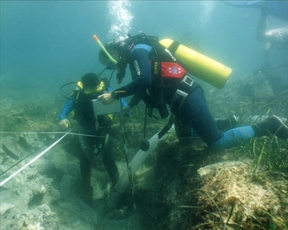
NewsWise
|
|
The cooperative project between the University of Haifa and Ankara University sparked local interest, not only in marine archaeology, but also in the team of Israeli archaeologists.
Israeli-Turkish relations have had their ups and downs over the past few years, but the cooperation between the Institute for Marine Studies at the University of Haifa and Ankara University has continually strengthened.
|
In 2000, Prof. Hayat Erkanal of Ankara University invited Prof. Michal Artzy and scholars from the University of Haifa to join them in archaeological excavations in the port of Urla, a port city located near Izmir, with more than 5,000 years of maritime history.
Remnants of an ancient port were uncovered during the excavations.
The finds revealed that the port, which served the ancient Greek settlement of Klazomenai, sunk following a natural disaster, probably an earthquake, in the 6th century BC. As there is no record of any such event occurring during this period, the actual cause of port’s destruction remains a mystery.
As there is no record of any such event occurring during this period, the actual cause of port’s destruction remains a mystery.”
[Full Story]
“Chinese navy dives for golden junk”
May 13, 2007, The Sunday Times, UK:
“China has sent its navy to protect marine archeologists on an expedition that salvaged more than 10,000 pieces of antique porcelain from a sunken junk in a campaign against looters and art smugglers.
It is believed to be the first time that China has deployed its armed forces to stop the plunder of its undersea cultural heritage along the ancient shipping routes, which are known in Chinese as the ‘silk road of the seas’.
Officials on Hainan Island, in the South China Sea, disclosed that naval vessels and units of the People’s Armed Police had accompanied diving teams on the 55-day mission, which ended last week.
‘This ship had been plundered many times since it was first discovered in 1996 by fishermen’, said an official of the Hainan cultural heritage bureau.
‘They were stealing everything and the ship was being damaged, so we’ve extracted the remaining relics and plan to raise the vessel later this year.’.
Navy gunboats and paramilitary guards escorted boats to and from the diving site in Chinese waters, as the archeologists ferried their finds back to Hainan, he said.”
[Full Story]
“‘SSCP has adverse security impact'”
May 12, 2007, News Today, India:
“Rameswaram Ram Setu Protection Movement (RRSPM) organized an International Seminar on scientific and security aspects of Setu Samudram Channel Project (SSCP) on 12 May, 2007 at Mylapore in Chennai. D Kuppuramu, Advocate and Convenor, Rameswaram Ram Setu Protection Movement (RRSPM) presided over the Seminar. Dr S R Rao, founder of Society of Marine Archaeology in India, who was scheduled to inaugurate the Seminar could not do so on account of his ill health.
SSCP which creates a channel passage in the Indian Ocean has serious security implications and disastrous impact on long-term ecological stability on the coastline of Tamilnadu and Kerala.
The adverse impact of the project on the marine resources and on the lives of fisher folk of Tamil Nadu and Kerala who are heavily dependent upon the fishery and aquatic resources of Gulf of Mannar and Palk Bay, were highlighted by all the experts who spoke at the Seminar.
Serious lapses in project design of the deep-water channel linking Bay of Bengal and Indian Ocean, underscored were that 1) the impact of a tsunami, on national security has not been studied and 2) no tsunami protection measures have been incorporated in the project.
Fisher folk in the Southern coastal districts of Tamilnadu are concerned that creating a de-facto international boundary by cutting a channel passage through Rama Setu, under pressure from the US Navy, will prevent the exercise of their historic rights in the Gulf of Mannar/Palk Bay.
In this context, the deliberations in the Seminar also specially noted the concerns expressed by 34 Sri Lankan experts in their report to their Foreign Secretary in April 2007, in particular: ‘The United Nations Law of the Sea mandates that neighbouring States need to be consulted and sufficient safeguards and guarantees provided… Dredging will also reduce the photosynthetic rate, resulting in the collapse of the fishing industry… It is also salient that no maritime archaeology has been conducted on this site.’
‘Scientific evidence, in a paper presented by Prof. Senanayake, indicates that 13,000-years ago, the area around the Kalpitiya lagoon, up to Mannar, were forested. Even today, stumps of old trees are found underwater.’“
[Full Story]
“Sunken ship yields ancient treasures”
May 09, 2007, IOL/Sapa-AFP, South Africa:
“China’s archaeologists have discovered over 10,000 pieces of porcelain and other relics on an ancient ship that sank in the South China Sea more than 700 years ago, state press said on Wednesday.
The ship dates to the Southern Song Dynasty (1127-1279) and measures 20 metres in length with a displacement of up to 60 tonnes, the Hainan Daily said.
Eleven cabins were still intact along the bottom of the boat’s wooden hull, it said.”
[Full Story]
“History-making sunken ship salvage may shed light
on three puzzles: experts”
May 07, 2007, People’s Daily, China:
“The salvage of a 800-year-old wooden ship off south China coast may help ravel three prominent puzzles surrounding the sunken boat of Southern Song Dynasty (1127-1279), Chinese experts say.
The three puzzles include whether the submerging of the Southern Song Dynasty ship was caused by overloading, where the ill-fated ship departed from, and what was inside the subsistence cabin.
The salvage operation, scheduled to start on Tuesday, is claimed to be first of its kind in the world. The sunken ship will be hoisted out of the seawater in July, according to Wu Jiancheng, who is in charge of the salvage operation.
Early on Sunday, a tug boat set sail from a dock in Guangzhou, a city on the Pearl River, for South China Sea waters 30 nautical miles off Hailing Isle near Yangjiang, south China’s Guangdong Province, shipping a huge, double-box steel structure specially made for the salvage operation.
The tug boat will reach the destination on Tuesday. Finding of Nanhai No.1 wooden ship.
The sunken ship was found accidentally in 1987 by Guangzhou Salvage Bureau and an underwater salvage company of Britain. It was the first ancient vessel discovered on the “Marine Silk Road” in the South China Sea and was named “Nanhai No.1”, meaning South China Sea No.1.
The ship is located some 30 nautical miles west of Hailing Island of Yangjiang City in south China’s Guangdong Province, and more than 20 meters deep in the sea. With a length of more than 25 meters, the ship is the largest cargo ship from the Song Dynasty so far discovered.”
[Full Story]
“‘Steel box’ sails off to salvage ancient ship”
May 06, 2007, XinhuaNet, China:
“A towboat carrying a huge ‘steel box’ will leave the port of Guangzho in south China on Sunday morning to begin salvage work on an 800-year-old ship, the most precious ancient ship found so far in the world.
The towboat with the ‘steel box’ will sail for 2 days before reaching the working waters, some 20 nautical miles west of Hailing Island of Yangjiang City in south China’s Guangdong Province, according to the Guangzhou Daily.
The sunken ship, which dates back to the early Southern Song Dynasty (1127-1279), was the first ancient vessel discovered on the ‘Marine Silk Road’ of the South China Sea and was named ‘Nanhai No.1’, meaning South China Sea No.1.
Nanhai No.1 was found accidentally in 1987. The ship, more than 25 meters long, is the largest cargo ship from the Song Dynasty so far discovered. The total value of the shipwreck may be over 100 billion U.S. Dollars.
Green glazed porcelain plates, tin pots, shadowy blue porcelains and other rare antiques have been found during the initial exploration of the ship. Archaeologists estimate that there are probably 50,000 to 70,000 relics on the ship, and that the archeological value of unveiling Nanhai No.1 is no worth less than discovering the terracotta warriors of the Emperor Qinshihuang.”
[Full Story]
“Mini-continent once joined to India discovered”
May 05, 2007, Kalinga Times, India:
“A mini-continent that was formerly joined to India has been discovered deep under the southern oceans by the world’s most powerful ice research vessel, said German scientists.
They spoke as the ship, the Polarstern, was due to dock Saturday in its homeport of Bremerhaven, Germany after a 19-month research voyage to Antarctica.
The ninth phase of the voyage was a study of the undersea Kerguelen Plateau, which was orphaned after the ancient continents separated, with India drifting away from Antarctica.
The findings suggest that the plateau, about the size of Germany and France combined, is just the tip of a bigger piece of lost continental crust, the scientists said Friday.
Geophysicists did seismic and magnetic surveys to explore the gap between the little-understood plateau and East Antarctica, the Alfred Wegener Institute of polar research in Bremerhaven said.”
[Full Story]
“‘Ramar Sethu not religious issue'”
May 05, 2007, Chennai Online, India:
“Taking exception to Tamil Nadu Chief Minister M Karunanidhi’s remarks that religious fundamentalists were opposing the SethuSamudram Canal project, the BJP’s state unit today said the issue was not a religious one, but that concerning protecting of an ‘ancient monument’.
‘Portraying agitations to protect Ramar Sethu bridge as opposition to the SSCP and labelling them as communal is condemnable’, BJP state president L Ganesan said in a statement here.
Demands for archeological research on Ramar Sethu bridge was as justifiable as those for excavation of Lemuria continent (a land mass under the Indian Ocean, said to be the home of Tamils) and Poompuhar (an ancient port city of Tamil kings of Chola dynasty), he said, adding if the Ramar Sethu bridge was demolished,no archeaological research was possible.”
[Full Story]
“Wooden piece at Dwarka site to tell all … date, time”
May 04, 2007, Ahmedabad Newsline, India:
“Archaeologists are excited about a circular wooden structure found underwater at a near-shore excavation site off the coast of Jamnagar. Thought to be the remains of the lost city of ancient Dwarka, the wooden structure is well preserved and surrounded by another structure made of stone blocks.
‘It is significant as scientific dating of wood, which is carbon, is possible. This was not the case with evidences like stone, beads, glass and terracota found earlier’, said Alok Tripathi, Superintending Archeologist, Underwater Archeology Wing of Archaeological Survey of India.
The dating of submerged ruins off the coast of Dwarka has been matter of debate for since long. Archaeologists and historians have been at loggerhead about the period when these structures were built and have claimed various dates about the origin and decay of one of the most scared places in India.
Answers to questions like when did Lord Krishna set up his kingdom in Dwarka? When did the ‘Golden City’ submerge in the sea? — were based on the interpretations of these scholars and no material evidence had so far been found so that these structures could be scientifically dated.
‘Though excavation at Dwarka has been carried out a number of times, this is for the first time a wooden block has been found, and this is going to help us almost pin-point a time frame and give some credible answers’, said Tripathi.”
[Full Story]
“Smugglers eye underwater treasures”
April 25, 2007, MathabaNet, UK:
“Foreign smugglers and antiques raiders are using sophisticated salvage equipment to steal China’s underwater treasures, an investigation by the Cultural Heritage Administration has found.
In China’s territorial sea, there are thousands of sunken ships carrying ancient treasures, mostly priceless porcelain.
Shan Jixiang, director of the State Administration of Cultural Heritage, told China Daily that the illegal foreign salvage ships were often equipped with the most advanced technology, in contrast with rudimentary ships and equipment used by Chinese archaeologists and conservationists, who are trying to protect China’s underwater heritage.
Smuggler activities have been particularly heavy over the last two years.
The relics are traded on the international waters beyond China’s maritime boundaries before they are shipped to markets worldwide, many to the United States.”
[Full Story]
“Prehistoric playground found below the waves”
April 25, 2007, The Sydney Morning Herald, Australia:
“A lost landscape where early humans roamed more than 12,000 years ago has been discovered beneath the North Sea.
A map of the underwater world reveals criss-crossing rivers, giant lakes and gentle hills around which hunter-gatherers made their homes toward the end of the last ice age.
The region was inundated between 18,000 and 6000BC, when the warming climate melted the thick glaciers that pressed down from the north.
As the water rose, the great plain vanished, and slowly the contours of the British Isles and the north-west European coastline were established. Now the primitive landscape is submerged and preserved, tens of metres beneath one of the busiest seas in the world.”
[Full Story]
“Lost world warning from North Sea”
April 20, 2007, BBC Science News, UK:
“Archaeologists are uncovering a huge prehistoric ‘lost country’ hidden below the North Sea. This lost landscape, where hunter-gatherer communities once lived, was swallowed by rising water levels at the end of the last ice age.
|
How a homestead might have looked in the flooded area
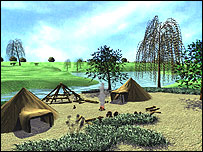
BBC Science News
|
|
University of Birmingham researchers are heralding ‘stunning’ findings as they map the ‘best-preserved prehistoric landscape in Europe’.
This large plain disappeared below the water more than 8,000 years ago.
|
The Birmingham researchers have been using oil exploration technology to build a map of the once-inhabited area that now lies below the North Sea – stretching from the east coast of Britain up to the Shetland Islands and across to Scandinavia.
|
The rising water levels began to remake the coastline
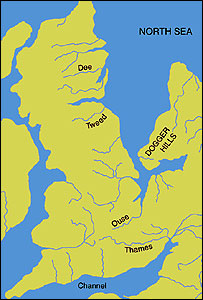
BBC Science News
|
|
‘It’s like finding another country’, says Professor Vince Gaffney, chair in Landscape Archaeology and Geomatics.
It also serves as a warning for the scale of impact that climate change can cause, he says. Human communities would have lost their homelands as the rising water began to encroach upon the wide, low-lying plains.
‘At times this change would have been insidious and slow – but at times, it could have been terrifyingly fast. It would have been very traumatic for these people’, he says.
|
‘It would be a mistake to think that these people were unsophisticated or without culture… they would have had names for the rivers and hills and spiritual associations – it would have been a catastrophic loss’, says Professor Gaffney.
As the temperature rose and glaciers retreated and water levels rose, the inhabitants would have been pushed off their hunting grounds and forced towards higher land – including to what is now modern-day Britain.”
[Full Story]
“Britain’s Lost World: A Time Team Special” is on UK Channel 4 at 20:00 BST on Tuesday 24 April, 2007 [JM.]
“The wave that destroyed Atlantis”
April 20, 2007, BBC Science News, UK:
“The legend of Atlantis, the country that disappeared under the sea, may be more than just a myth. Research on the Greek island of Crete suggests Europe’s earliest civilisation was destroyed by a giant tsunami.
|
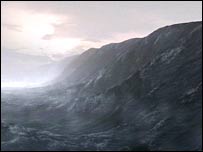
BBC Science News
|
|
Until about 3,500 years ago, a spectacular ancient civilisation was flourishing in the Eastern Mediterranean.
The ancient Minoans were building palaces, paved streets and sewers, while most Europeans were still living in primitive huts.
|
But around 1500BC the people who spawned the myths of the Minotaur and the Labyrinth abruptly disappeared. Now the mystery of their cataclysmic end may finally have been solved.
A group of scientists have uncovered new evidence that the island of Crete was hit by a massive tsunami at the same time that Minoan culture disappeared.
‘The geo-archaeological deposits contain a number of distinct tsunami signatures’, says Dutch-born geologist Professor Hendrik Bruins of the Ben-Gurion University of the Negev in Israel.
‘Minoan building material, pottery and cups along with food residue such as isolated animal bones were mixed up with rounded beach pebbles and sea shells and microscopic marine fauna.’.
‘The latter can only have been scooped up from the sea-bed by one mechanism – a powerful tsunami, dumping all these materials together in a destructive swoop’, says Professor Bruins.”
[Full Story]
“Timewatch: The wave that destroyed Atlantis” is on BBC Two at 21:00 BST on Friday 20 April, 2007 [JM.]
“Dwarka artefacts show link between Indian,
Roman civilisations”
March 30, 2007, EarthTimes, USA:
“Scientists from the city-based National Institute of Oceanography (NIO) have found artefacts near Dwarka island off Gujarat coast which indicate close links between Indian and Roman civilisations.
‘During the excavation, we found artefacts dating back 3,500 years which indicate that India’s maritime history is much older and Indians used to travel by sea even before Vasco da Gama touched Indian shores’, said Dr K H Vora, deputy director and project leader, Marine Archaeology.
‘Archaeological excavations at Bet (island) Dwarka, which is the western-most part of India, also revealed an interesting cultural sequence commencing from pre-historic period (3,800 years Before Present) to historical period (1,600 Before Present)’, he said. ‘Interestingly, we came across amphorae shreds of Mediterranean origin’.
‘This indicates that Indian and Roman civilisations have similarities with each other through sea route’, Vora stated. NIO’s Marine Archaeology wing which is continuously exploring coasts of Somnath, Vijaydurg, Sindhudurg and Goa besides Dwarka, consider the revelation as a milestone in marine history.”
[Full Story]
“Maritime clues link ancient Indian and Roman civilizations”
March 30, 2007, EarthTimes, USA:
“Scientists from India’s National Institute of Oceanography have found artefacts near Dwarka island, off the coast of western Indian state Gujarat, indicating links between ancient Indian and Roman civilizations, reports said Friday.
‘During excavation, we found artefacts dating back to between starting of the christian era and 2 AD. These indicate that India’s maritime history is much older and Indians used to travel by sea even before Vasco da Gama touched Indian shores’, K H Vora, deputy director of marine archeology and project leader, told news agency PTI.
‘During archaeological underwater excavations at Dwarka, the westernmost part of India, we excavated pottery belonging to the ancient Indian Harrappan civilization, a fish hook from the bronze era, and amphorae shreds of Mediterranean origin’, Vora said, referring to remnants of clay containers used by Romans to transport wine.
‘This indicated that Indian and Roman civilizations have similarities with each other through sea routes’, he said.”
[Full Story]
“Wreck could yield over $1b in treasure”
March 27, 2007, People’s Daily, China:
“Up to a billion dollars worth of gold and silver on a sunken 17th-century English warship may soon be recovered.
Professional marine treasure hunters working with the British government have reportedly been given the go-ahead to recover gold and silver pieces from what is thought to be the wreck of the HMS Sussex, which took 560 sailors to a watery grave off Gibraltar in 1694.
Although the Spanish government had given its approval, until Friday the regional government of Andalucia had been blocking progress towards recovering the 10 tonnes of gold and silver believed to have gone down with the vessel.
An American ship, belonging to Florida-based Odyssey Marine exploration company, has been scanning the sea bed off Gibraltar for almost a decade. The 1,000 square kilometers of Mediterranean sea bed have turned up dozens of ancient wrecks.”
[Full Story]
“Can the monkey god save Rama’s underwater bridge?”
March 27, 2007, The Times, UK:
“Hindu groups are launching an international campaign today to halt India’s plans to create a shipping channel by dredging the sea between India and Sri Lanka.
They say that the project will destroy an ancient chain of shoals known as Adam’s Bridge, which Hindus believe was built by an army of monkeys to allow Lord Rama to cross to Lanka to rescue his abducted wife. They are also protesting on environmental grounds, arguing that the 30-mile string of limestone shoals, also known as Ram Sethu, protected large parts of India from the 2004 tsunami.
Central to the controversy is the question of whether Adam’s Bridge is man-made or a natural formation. The bridge is believed by some to have been passable on foot as recently as the 15th century.
According to Hindu belief set out in the epic poem the Ramayana, it was built about 3,500 years ago. Its purpose was to allow Lord Rama, one of the great kings of ancient India and an avatar of the god Vishnu, to travel from India to Sri Lanka, where he defeated the demonic tyrant Ravana and rescued his wife, Sita.
In 2002, Hindu nationalists cited Nasa satellite photographs of the shoals as evidence that the events described in the Ramayana really took place, although Nasa has distanced itself from those claims.
This month a panel of Indian scientists concluded that the bridge was ‘a geological formation, which took place about 17 million years ago’.
They could not, however, explain a mysterious series of accidents which have stalled work. First, the dredging vessel Duck6 sank. It was replaced by the Dredging Corporation of India’s biggest dredging vessel, but its spud broke. Another ship was then sent to retrieve the spud, but its crane snapped and crashed into the sea.
At least one Hindu leader has suggested that the bridge is being protected by Lord Hanuman, the Hindu monkey god.”
[Full Story]
“Shipwreck mystery uncovered on beach”
March 26, 2007, The Courier, Scotland:
“Have the shifting sands of Montrose beach revealed the other half of a 19th century shipwreck uncovered last year?
|
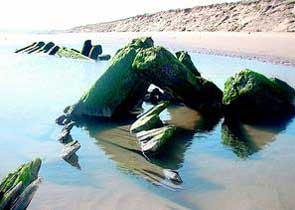
The Courier, Scotland
|
|
It was about this time last year that the bow section of a wooden boat, long buried beneath the sands, was exposed for a brief period by the movement of the tides at the north end of the beach.
Last week another wreck partially reappeared, around half a mile further along the beach.
|
‘It is of similar construction to last year’s wreck and this time it is a stern section, with the rudder still clearly visible’, said local shipping historian John Aitken.
‘Although many boats have foundered in Montrose Bay in high seas and there must be many wrecks under the sand, there is a possibility that this latest find, some distance away from last year’s, may be the opposite end of the same boat.’“
[Full Story]
“Spain, Britain to dive for treasure on 1694 wreck”
March 24, 2007, Reuters, UK:
“Three hundred years after the British warship Sussex sank in a storm off southern Spain, researchers are preparing to dive to the site to see if it was carrying a fortune in gold coins.
Spain and Britain said on Friday they had agreed to start underwater exploration to find the ship that sank near Gibraltar in 1694.
Any treasure will be claimed by Britain, the Spanish foreign ministry said in a statement.”
[Full Story]
“Underwater city Dwarka in Arabian Sea getting buried”
March 21, 2007, India Post, India:
“The excavated city of Dwarka, the pristine abode of Lord Krishna, discovered by the octogenarian archeologist S R Rao under the Arabian Sea in the coast of Gujarat is once again getting buried under the sands, thanks to neglect by the authorities.
This ‘under sea city of Dwarka’ lies in close proximity to near the present Dwarka temple in Saurashtra. According to archeologists this under-sea city was the real Dwarka where Lord Krishna lived.
This was discovered by Rao and his team during an underwater excavation in 1994. The excavation had lasted for nearly 14 years.
A proposal by Rao to develop the site as underwater tourist attraction by cleaning up the site, provide support to the structures and shield them from degeneration has remained in the dusty shelves of the government.”
[Full Story]
“No signs of ancient underwater human habitation found”
March 13, 2007, KHOU News, USA:
“The underwater explorers who spent last week scouring the offshore continental shelf for signs of 19,000-year-old human habitation sailed back to Galveston empty-handed Saturday.
The crew of geologists, biologists and marine archeologists was hoping to find clues of human activity in the area during the last Ice Age, when they believe the Texas coastline extended 100 miles into the Gulf of Mexico.
The expedition did not turn up anything definitive, but the scientists did find what they believe to be signs of the ancient shoreline about 330 feet below the ocean’s surface.
‘A series of long vertical steps look like they may have been created by the movement of waves, which carve out a trough and deposit material farther up’, wrote team member Todd Viola, who posted mission logs daily on the expedition’s Web site. ‘This is the same profile we see on modern beaches.’
Viola described the find as very exciting but noted further exploration would be necessary to verify the scientists’ theory.”
[Full Story]
“Undersea expedition finds ‘promising’ data”
March 12, 2007, KazInform, Kazakhstan:
“A submarine expedition to the floor of the Gulf of Mexico has returned with “promising” clues regarding an ancient undersea shoreline there.
Anthropologist David Robinson told the Houston Chronicle that the expedition at the Flower Garden Banks National Marine Sanctuary yielded some significant data, yet was hesitant to say the area was 20,000 years old.
‘We found an area that looks like a promising place to do further research’, he said of the 6-mile-long studied area.”
[Full Story]
“Ship Excavation Sheds Light on Napoleon’s Attack
on the Holy Land”
March 05, 2007, NewsWise, USA:
“A ship that sunk off the coast of Acre during the battles between Napoleon and the British Royal navy is still shrouded in mystery. Marine archaeologists from the University of Haifa are analyzing the hull and the finds in an effort to solve the mystery.
|
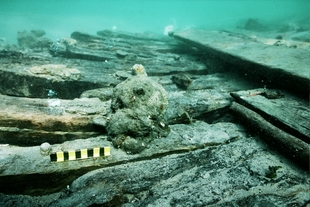
Steve Breitstein for NewsWise
|
|
Which navy commissioned the boat that sunk off the coast of Acre 200 years ago, which battles was it involved in and how did it end up at the bottom of the sea?
The recent findings of marine archaeologists at the Leon Recanati Institute for Maritime Studies of the University of Haifa may provide the answers to these questions.
|
The ship, which sunk off the coast of Acre during a battle between Napoleon, the British navy and possibly the defenders of Acre, 200 years ago, is under excavation and its finds are beginning to shed light on Napoleon’s attempt to conquer the Holy Land.
Recent marine excavations found cannon balls, canisters of gun powder and other items that will help give evidence as to the ship’s journey and answer the questions facing marine archaeologists. It is not clear if the boat was involved in battles in 1799 or 1840, if it was a French or British boat or even if the boat sunk or was sunk.
‘This is the only shipwreck excavated from the period of the French blockade of Acre and it can teach us a lot about the naval battles of that period’, explained Dr. Ya’acov Kahanov from the Leon Recanati Institute for Maritime Studies and the Department Of Maritime Civilizations at the University of Haifa.”
[Full Story]
“Science Team to Search Gulf of Mexico”
March 02, 2007, Examiner, USA:
“Famed undersea explorer Robert Ballard is leading a team of scientists heading into the Gulf of Mexico for a weeklong examination of Texas’ ancient shoreline to see if anybody may have lived there.
Ballard, whose discoveries include the wrecks of the Titanic and the German battleship Bismarck, is among dozens of geologists, biologists and marine archaeologists exploring the Flower Garden Banks National Marine Sanctuary, a protected area of underwater salt domes that are topped with reefs that host brightly colored sponges, plants and other marine life.
But 15,000 or more years ago, with much of North America locked in the last Ice Age, water levels of the Gulf of Mexico were 200 feet lower, meaning the area was the Texas shoreline some 100 miles south of where it is now.
The estimated $300,000 project will examine what scientists believe are those ancient shorelines. The team will leave from Galveston on Friday.
‘Certainly a major part is our quest for evidence of human habitation in the Flower Garden regions during the last Ice Age.’ Ballard said Thursday.”
[Full Story]
“Revealing Urla’s underwater treasures”
February 16, 2007, Turkish Daily News, Turkey:
“The aim of the Liman Tepe excavations is to uncover the complete port complex and settlement hidden underwater, which has thus far uncovered a sunken ship that is now on display at the Underwater Archaeology Museum in Urla.
|
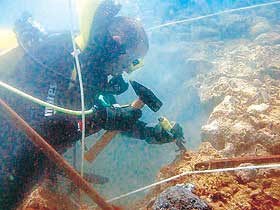
Turkish Daily News
|
|
The partially submerged Liman Tepe, a major Early Bronze Age harbor town located in I.zmir’s Urla district, possesses the world’s oldest breakwater, said archaeologist Professor Hayat Erkanal during a press conference last week.
Breakwaters, an important part of modern nautical life worldwide, are constructed on or near coastal areas as a defense from incoming waters that protects ships as well as land from harsh weather and high tides.
|
Erkanal, who is also the president of Ankara University’s Underwater Archaeological Research Center, has been the head of this excavation site since 1992 and presented information about the excavations at a press conference together with Urla Mayor Selçuk Karaosmanoglu.
Erkanal said their excavations continued both on land and underwater and their aim was to explore the hidden parts of the settlement buried underwater. “
[Full Story]
“Underwater museum to be opened soon in Urla”
February 16, 2007, Turkish Daily News, Turkey:
“Professor Hayal Erkanal who is managing ancient Limantepe excavation in Urla said that they have made big improvement underwater excavation and would open a museum where artifacts discovered from this underwater excavation.
Talking in a meeting attended by Urla Mayor Selçuk Karaosmanoglu, Erkanal said that most of ancient remains layed underwater: ‘We reached very important findings during this underwater excavation.’
‘We have capacity top en a museum where all these artifacts we discovered from the sea to would be exhibited.’.”
[Full Story]
“Fisherman nets rare medieval cooking pot”
February 07, 2007, Kilkenny Today, Ireland:
“A FISHERMAN at Drumdowney Point has found more than the catch of the day in his fishing nets – you might even call it the catch of six to eight centuries.
Sean Doherty, who lives on the opposite shore in Waterford, was fishing at the south Kilkenny spot about 40 metres from the shore line a year and a half ago, when he noticed in his net what he thought was a flower pot.
On second glance he saw that the pot was unusual in that the bottom was rounded rather than flat like a typical pot of today.
His keen eye for observation has been honed over many years picking up different pieces, and his interest in archaeology has been boosted from watching documentaries and other such programmes.
But little did he know that his discovery would end up on display in the National Museum in Dublin.
He initially brought the pot to the Waterford Treasures museum, and they in turn passed it on to the National Museum.”
[Full Story]
“Underwater Turkish-Japanese cooperation”
February 03, 2007, Turkish Daily News, Turkey:
“The Turkish frigate Ertugrul sank on the way back from Japan in 1890, where it was serving on a goodwill trip 117 years ago.
Last month a conference and expedition named ‘Waking the History Underwater’ was held at the Kushimoto Royal Hotel at the suggestion by the Japanese Diving Union. Turkish, U.S. and French scientists attended the conference to commemorate the 550 Ertugrul casualties and to find the remains of the sunken frigate.
Participants of the conference included two of the most important figures of archeology: U.S. professor George Bass, who has worked in Bodrum, Kas, and Datça since 1955, and Claude Duthuit, the former premier diver on Captain Cousteau’s crew.
Marine Staff Colonel Murat Saka who was on duty at the Turkish Embassy in Tokyo, President of the Archaeologists Union of the Wakeyama Region Hiroshi Onomoto, Kushimoto Mayor Mustafa Shigeki Matsubara and many archaeologists and divers participated in the conference.
After the exhibition a Japanese archaeologist decided to visit the Bodrum Underwater Archaeology Museum with his diving team in March.”
[Full Story]
“Ancient Chinese shipwreck auctioned”
February 01, 2007, India eNews, India:
“About 76,000 pieces of 18th century Chinese porcelain, salvaged from a ship that sank 280 years ago during its journey to Europe, were auctioned by Sotheby’s for more than 3 million euros (about $3.9 million).
‘We are absolutely delighted with the results of this sale. The buyers appreciated the quality of the porcelain that was produced in Jingdezhen’, said Mark Grol, director of Sotheby’s Amsterdam.
Vietnamese fishermen discovered the shipwreck in 1998. Some items from the cargo are now on display in Vietnamese museums.”
[Full Story]
“Shipwreck from the Early Islamic Period
discovered off Israeli coast”
January 23, 2007, NewsWise, USA:
“An 8th century shipwreck was discovered off Dor Beach and excavated by researchers from the Leon Recanati Institute for Maritime Studies of the University of Haifa. It is believed to be the only boat from this period discovered in the entire Mediterranean region.
|
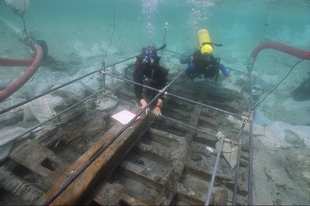
NewsWise, USA
|
|
‘We do not have any other historical or archaeological evidence of the economic activity and commerce of this period at Dor. The shipwreck will serve as a source of information about the social and economic activities in this area’, said Dr. Ya’acov Kahanov from the Leon Recanati Institute for Maritime Studies and the Department Of Maritime Civilizations at the University of Haifa.
|
The wreck itself was found almost a decade ago during a joint survey of the area conducted by an expedition of the Institute for Maritime Archaeology from the University of Texas A & M and the Recanati Institute for Maritime Studies at the University of Haifa.
Using carbon dating techniques, the wreck was dated as from the early 8th century. Only now, after the completion of the latest excavation season, are the details of the 1,300 year old shipwreck becoming clearer.”
[Full Story]
“117-year-old Turkish wreck off Kushimoto yields artifacts”
January 11, 2007, Asahi Shimbun, Japan:
“A metal cauldron thought to be from the Turkish frigate Ertugrul, which sank in 1890, was found Tuesday off the coast of Kushimoto, Wakayama Prefecture.
|
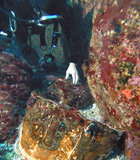
Asahi Shimbun, Japan
|
|
Divers on Tuesday began exploring the wreck of a Turkish frigate that sank off coastal waters here in 1890 after paying a friendship visit to Japan on behalf of the then Turkish Ottoman Empire (1299-1922).
The divers, led by the Institute of Nautical Archaeology at Texas A&M University in College Station, Texas, will use sonar to look for artifacts through Jan. 25.
|
After leaving port for its return to Turkey, the wooden frigate Ertugrul foundered on rocks during a storm and was battered by the elements for four days before it came to grief.
It eventually sank near Oshima Island, now part of Kushimoto at the southern tip of Wakayama Prefecture.”
[Full Story]
“Maine Fisherman Makes Mammoth Find”
January 05, 2007, KCSH-TV News, USA:
“A fisherman from Cushing recently caught more than he expected off Georges Bank, and now wants to find out what it really is.
Tim Winchenbach was working on a scallop dragger when he found what appears to be a wooly mammoth’s tusk.
Wooly mammoths or mastodons are long extinct. A scientist at the University of Maine says the ancient creatures could have lived in the Georges Bank area 13,000 years ago, during the ice age, because some of that area was dry land at the time.
Winchenbach says he has seen whale bones before, and is convinced its not that or any other sea creature.
Now he and his family are waiting for some experts to see it for themselves. They have sent photos of the tusk to a researcher at the Maine State Museum.”
[Full Story]
“Tide uncovers 3,500-year-old King Road in Bodrum”
January 05, 2007, Turkish Daily News, Turkey:
“A drop in the sea level around Tavsan Adas, or Rabbit Island, in Bodrum’s Gümüslük district has revealed the ancient King Road.
|
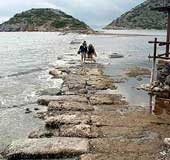
Turkish Daily News
|
|
The 150-meter-long road is believed to be where King Maussolus of Halicarnassus (modern-day Bodrum), his sister Artemisia and his beloved used to spend their time and watch the Aegean sunset.
Gümüs,lük Mayor Mehmet Ülküm said shifting tides occurred in the region from time to time, adding:
|
‘However, this time the fall in sea level is unexpectedly large. It is really very exciting to walk along King Road and visit Rabbit Island. We have documented this historic moment with photographs and images. If the sea level doesn’t rise again, we will protect King Road and provide visitors with information about its history.’“
[Full Story with larger image]
“Maine Fisherman Makes Mammoth Find”
January 05, 2007, KCSH-TV News, USA:
“A fisherman from Cushing recently caught more than he expected off Georges Bank, and now wants to find out what it really is.
Tim Winchenbach was working on a scallop dragger when he found what appears to be a wooly mammoth’s tusk.
Wooly mammoths or mastodons are long extinct. A scientist at the University of Maine says the ancient creatures could have lived in the Georges Bank area 13,000 years ago, during the ice age, because some of that area was dry land at the time.
Winchenbach says he has seen whale bones before, and is convinced its not that or any other sea creature.
Now he and his family are waiting for some experts to see it for themselves. They have sent photos of the tusk to a researcher at the Maine State Museum.”
[Full Story]
“Historic sea map set for auction”
January 04, 2007, BBC Science News, UK:
“A historic map of Scotland is to be auctioned in Edinburgh. The Nicolay Rutter is said to be the oldest accurate chart of the country. It was made from a voyage King James V took around Scotland in 1540.
|
The map was said to be a
great advance in cartography
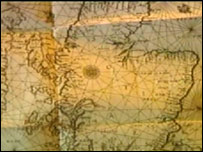
BBC Science News
|
|
The rutter, which goes on sale on 10 January, is expected to fetch more than £12,000 because of its importance to map making and political history.
There are several copies of the rutter in existence but the sale is expected to interest international collectors.
|
Auctioneers Lyon and Turnbull said the rutter, which takes its name from the French word routier, is a set of sailing directions.
The voyage of James V named on the title-page is that of 1540, when the king, with several nobles, set out to subdue the unruly lords of the Western Isles.”
[Full Story]
|



















